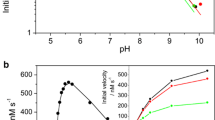Abstract.
Trapping malate dehydrogenase from the extremely halophilic archaeon Haloarcula marismortui in "dry" salt crystals protects the enzyme against thermal denaturation. Similar protection was not observed for the homologous mesophilic enzyme. In the case of transfer RNA molecules, high salt concentration plays a protective role against thermal degradation allowing activity to be recovered. The results are discussed in the context of exploring the fate of cell-free biological macromolecules in the environment and that of orienting the search for traces of life in planetary exploration.
Similar content being viewed by others
Author information
Authors and Affiliations
Additional information
Electronic Publication
Rights and permissions
About this article
Cite this article
Tehei, M., Franzetti, B., Maurel, MC. et al. The search for traces of life: the protective effect of salt on biological macromolecules. Extremophiles 6, 427–430 (2002). https://doi.org/10.1007/s00792-002-0275-6
Received:
Accepted:
Issue Date:
DOI: https://doi.org/10.1007/s00792-002-0275-6




